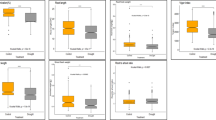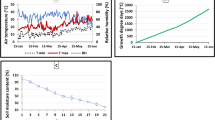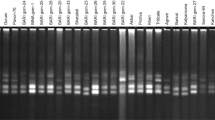Abstract
Wheat (Triticum aestivum L.) is predominantly growing in areas where terminal drought stress is the foremost yield-limiting factor. Since genetic variability for drought tolerance is weakened in modern wheat cultivars, exploring the drought tolerance potential of the synthetic backcross-derived wheat lines (SBL) might help to widen genetic diversity for wheat breeders. The variation among 45 selected SBLs in response to drought stress was assessed by measuring physio-agronomic traits under induced drought stress at the reproductive stage in comparison to 5 known drought tolerant commercial wheat varieties as check. The variability among genotypes was verified by analysis of variance, principal component analysis, a heat map, and clustering methods using Ward’s method. The study selected 12 SBLs with significantly higher grain yields than 5 local checks under drought stress. The drought tolerance ability of these selected genotypes was strongly associated with proline, leaf water contents, membrane stability, and better leaf chlorophyll contents under drought stress. The identified tolerant SBLs may prove useful wheat lines for wheat breeders to evolve drought-tolerant wheat varieties.



Similar content being viewed by others
Data availability
The data generated and analyzed during the current study are available from the corresponding author on reasonable request.
References
Adinsoft S (2010) XLSTAT-software, version 10. Addinsoft, Paris. https://doi.org/10.1177/2048872614530665
Ahmadi A, Baker DA (2001) The effect of water stress on the activities of key regulatory enzymes of the sucrose to starch pathway in wheat. Plant Growth Regul 35:81–91. https://doi.org/10.1023/A:1013827600528
Asada K (2006) Production and scavenging of reactive oxygen species in chloro-plasts and their functions. Plant Physiol 141:391–396. https://doi.org/10.1104/pp.106.082040
Barrs HD, Weatherley PE (1962) A re-examination of the relative turgidity techniques for estimating water deficits in leaves. Aust J Biol Sci 15:413–428. https://doi.org/10.1071/BI9620413
Bates LS, Waldren RP, Teare ID (1973) Rapid determination of free proline for water-stress studies. Plant Soil 39:205–207. https://doi.org/10.1007/BF00018060
Burton GW, DeVane EH (1953) Estimating heritability in tall fescue (Festuca arundinacea) from replicated clonal material 1. Agron J 45(10):478–481. https://doi.org/10.2134/agronj1953.00021962004500100005x
Cattivelli L, Rizza F, Badeck FW (2008) Drought tolerance improvement in crop plants: an integrated view from breeding to genomics. Field Crops Res 105:1–14. https://doi.org/10.1016/j.fcr.2007.07.004
Chandler JM (2001) Current molecular understanding of the genetically programmed process of leaf senescence. Physiol Plant 113:1–8. https://doi.org/10.1034/j.1399-3054.2001.1130101
Deshmukh PS, Sairam RK, Shukla DS (1991) Measurement of ion leakage as screening technique for drought resistance in wheat genotypes. Indian J Plant Physiol 34:89–91
Dodig D, Zoriæ M, Kandiæ V, Peroviæ D, Surlan−Momiroviæ, (2012) Comparison of responses to drought stress of 100 wheat accessions and land races to identify opportunities for improving wheat drought resistance. Plant Breed 131:369–379. https://doi.org/10.1111/j.1439-0523.2011.01941.x
Dorion S, Lalonde S, Saini HS (1996). Induction of male sterility in wheat by meiotic-stage water deficit is preceded by a decline in invertase activity and changes in carbohydrate metabolism in anthers. Plant Physiol 111: 137–145. https://www.jstor.org/stable/4277145
Easterling W, Apps M (2005) Assessing the consequences of climate change for food and forest resources: a view from the IPCC. Clim Change 70:165–189. https://doi.org/10.1007/1-4020-4166-7_8
Ehlers W, Goss M (2003) Water dynamics in plant production. CABI Publishing, Wallingford. https://doi.org/10.1079/9780851996943.0000
Farooq M, Wahid A, Kobayashi N, Fujita D, Basra SMA (2009) Plant drought stress: effects, mechanisms and management. Agron Sustain Dev 29:185–212. https://doi.org/10.1051/agro:2008021
Fleury DS, Kuchel H, Langridge P (2010) Genetic and genomic tools to improve drought tolerance in wheat. J Exp Bot 61:3211–3222. https://doi.org/10.1093/jxb/erq152
Flexas J, Medrano H (2002) Energy dissipation in C3 plants under drought. Funct Plant Biol 29:1209–1215. https://doi.org/10.1071/FP02015
Gregersen L, Holm B (2007) Transcriptome analysis of senescence in the flag leaf of wheat (Triticum aestivum L.). Plant Biotechnol J 5:192–206. https://doi.org/10.1111/j.1467-7652.2006.00232.x
Golabadi MA, Arzani SA, Maibodym M (2006) Assessment of drought tolerance in segregating populations in durum wheat. Afr J Agric Res 1:162–171. https://doi.org/10.5897/AJAR.9000070
Gororo NN, Eagles HA, Eastwood RF, Nicolas ME, Flood RG (2002) Use of Triticum tauschii to improve yield of wheat in low-yielding environments. Euphytica 123:241–254. https://doi.org/10.1023/A:1014910000128
Hafsi M, Mechmeche W, Bouamama L, Djekoune A, Zaharieva M, Monneveux P (2000) Flag leaf senescence, as evaluated by numerical image analysis, and its relationship with yield under drought in durum wheat. J Agron Crop Sci 185:275–280. https://doi.org/10.1046/j.1439-037x.2000.00436.x
IPCC (2022) Summary for policymakers. In Pörtner H-O, Roberts DC, Poloczanska ES, Mintenbeck K, Tignor M, Alegría A, Craig M, Langsdorf S, Löschke S, Möller V, Okem A (eds) Climate change 2022: impacts, adaptation, and vulnerability. contribution of working group II to the 6th assessment report of the intergovernmental panel on climate change. Cambridge University Press. https://www.ipcc.ch/report/ar6/wg2/downloads/report/IPCC_AR6_WGII_SummaryForPolicymakers.pdf
Janik G, Kłosowicz I, Walczak A, Adamczewska-Sowińska K, Jama-Rodzeńska A, Sowiński A (2021) Application of the TDR technique for the determination of the dynamics of the spatial and temporal distribution of water uptake by plant roots during injection irrigation. Agric Water Manag 252:106911. https://doi.org/10.1016/j.agwat.2021.106911
Knox J, Hess T, Daccache A, Wheeler T (2012) Climate change impacts on crop productivity in Africa and South Asia. Environ Res Lett 7:1–8. https://doi.org/10.1088/1748-9326/7/3/034032
Lawlor DW, Cornic G (2002) Photosynthetic carbon assimilation and associated metabolism in relation to water deficits in higher plans. Plant Cell Environ 25:275–294. https://doi.org/10.1046/j.0016-8025.2001.00814.x
Liang Y, Zhang K, Zhao L, Liu B, Meng Q (2010) Identification of chromosome regions conferring dry matter accumulation and photosynthesis in wheat (Triticum aestivum L.). Euphytica 171:145–156. https://doi.org/10.1007/s10681-009-0024-3
Lobell DB, Burke MB, Tebaldi C, Mastrandrea MD, Falcon WP, Naylor RL (2008) Prioritizing climate change adaptation needs for food security in 2030. Science 319:607–610. https://doi.org/10.1126/science.1152339
Lopes MS, Reynolds MP (2011) Drought adaptive traits and wide adaptation in elite lines derived from resynthesized hexaploid wheat. Crop Sci 51:1617–1626. https://doi.org/10.2135/cropsci2010.07.0445
Maes B, Trethowan RM, Reynolds MP, van Ginkel M, Skovmand B (2001) The influence of glume pubescence on spikelet temperature of wheat under freezing conditions. J Plant Physiol 28:141–148. https://doi.org/10.1071/PP00049
Medrano H, Escalona JM, Bota J, Gulias J, Flexas J (2002) Regulation of photosynthesis of C3 plants in response to progressive drought: stomatal conductance as a reference parameter. Ann Bot 89:895–905. https://doi.org/10.1093/aob/mcf079
Mohammadi R, Armion M, Kahrizi D, Amri A (2010) Efficiency of screening techniques for evaluating durum wheat genotypes under mild drought conditions. Int J Plant Prod 4:11–24. https://doi.org/10.22069/IJPP.2012.677
Nehe AS, Foulkes MJ, Ozturk I, Rasheed A, York L, Kefauver SC (2021) Root and canopy traits and adaptability genes explain drought tolerance responses in winter wheat. PLoS One 16(4):1–25. e0242472. https://doi.org/10.1371/journal.pone.0242472
Palta JP (1990) Stress interactions at the cellular and membrane level. Hort Sci 25:1337–1381. https://doi.org/10.21273/HORTSCI.25.11.1377
Pask A, Pietragalla J, Mullan D, Reynolds M (2012) Physiological breeding II: a field guide to wheat phenotyping. CIMMYT, Mexico. https://www.researchgate.net/publication/268743172_Physiological_Breeding_II_A_Field_Guide_to_Wheat_Phenotyping
R Core Team (2018) R: a language and environment for statistical computing. R Foundation for Statistical Computing, Vienna. https://www.R-project.org/
Reynolds MP, Dreccer F, Trethowan R (2007) Drought adaptive traits derived from wheat wild relatives and landraces. J Exp Bot 58:177–186. https://doi.org/10.1093/jxb/erl250
Sareen S, Tyagi BS, Sarial AK, Tiwari V, Sharma I (2014) Trait analysis, diversity, and genotype x environment interaction in some wheat landraces evaluated under drought and heat stress conditions. Chil J Agric Res 74:135–142. https://doi.org/10.4067/S0718-58392014000200002
Skovmand B, Reynolds MP, DeLacy IH (2001) Searching genetic resources for physiological traits with potential for increasing yield. In: Reynolds MP, Ortiz-Monasterio I, McNab A (eds) Application of physiology in wheat breeding, pp 17–28. Mexico, DF, CIMMYT. https://www.academia.edu/8808924/Phenotyping_approaches_for_physiological_breeding_and_gene_discovery_in_Wheat
Slafer GA, Savin R, Sadras VO (2014) Coarse and fine regulation of wheat yield components in response to genotype and environment. Field Crops Res 157:71–83. https://doi.org/10.1016/j.fcr.2013.12.004
Sohail M, Hussain I, Riaz-ud-Din, Tanveer SK, Qamar M, Abbas SH (2014) Physio-agronomic traits evaluation of wheat genotypes for adaptability under rainfed conditions. Sarhad J Agric 30(2):51–156. https://agris.fao.org/agris-search/search.do;jsessionid=19ECBD90D8D161950221A747A173FC95?request_locale=fr&recordID=PK2015000273&query=&sourceQuery=&sortField=&sortOrder=&agrovocString=&advQuery=¢erString=&enableField=
Sohail M, Hussain I, Qamar M, Tanveer SK, Abbas SH, Ali Z, Imtiaz M (2019) Evaluation of spring wheat genotypes for climatic adaptability using canopy temperature as physiological indicator. Pak J Agric Res 33(1): 89–96. https://doi.org/10.17582/journal.pjar/2020/33.1.89.96
Szechyńska-Hebda M, Czarnocka W, Hebda M, Bernacki MJ, Karpiński S (2016) PAD4, LSD1 and EDS1 regulate drought tolerance, plant biomass production, and cell wall properties. Plant Cell Rep 35:527–539. https://doi.org/10.1007/s00299-015-1901-y
Trethowan RM, Reynolds MP, Sayre K, Ortiz-Monasterio I (2005) Adapting wheat cultivars to resource conserving farming practices and human nutritional needs. Ann Appl Biol 146:405–413. https://doi.org/10.1111/j.1744-7348.2005.040137.x
Talebi R, Fayaz F, Naji N (2009) Effective selection criteria for assessing drought stress tolerance in durum wheat (Triticum durum Desf.). Gen Appl Plant Physiol 35:64–74. https://www.researchgate.net/publication/260294625_Effective_selection_criteria_for_assessing_drought_stress_tolerance_in_durum_wheat_Triticum_durum_Desf
Yang J, Sears RG, Gill BS, Paulsen GM (2002) Growth and senescence characteristics associated with tolerance of wheat-alien amphiploids to high temperature under controlled conditions. Euphytica 126:185–193. https://doi.org/10.1023/A:1016365728633
Yang J, Zhang J, Wang Z, Zhu Q, Liu L (2001) Water deficit–induced senescence and its relationship to the remobilization of pre-stored carbon in wheat during grain filling. Agron J 93(11–96):196–206. https://doi.org/10.2134/agronj2001.931196x
Zhang L, Mi X, Shao HB, Ma K (2011) Strong plant-soil associations in a heterogeneous subtropical broad-leaved forest. Plant Soil 347:211–220. https://doi.org/10.1007/s11104-011-0839-2
Acknowledgements
The authors acknowledge the financial support from the Agricultural Linkages Program (ALP) of the Pakistan Agricultural Research Council (PARC) for this study.
Funding
This research was funded by the Agricultural Linkages Program (ALP) of the Pakistan Agricultural Research Council (PARC) under Project Number: CS 369.
Author information
Authors and Affiliations
Contributions
M. Sohail perceived, designed the experiment, collected data, analysed the results, and wrote this article. M. Qamar assisted in data collection, laboratory assays and facilitated in conducting of the research. S. Waqar assisted in data collection. I. Hussain served as a research supervisor and aided in obtaining the funding and final review of the manuscript version to be submitted.
Corresponding author
Ethics declarations
Conflict of interest
The authors have no conflicts of interest or competing interests.
Consent for publication
All authors consent to publish.
Additional information
Publisher's Note
Springer Nature remains neutral with regard to jurisdictional claims in published maps and institutional affiliations.
Rights and permissions
Springer Nature or its licensor holds exclusive rights to this article under a publishing agreement with the author(s) or other rightsholder(s); author self-archiving of the accepted manuscript version of this article is solely governed by the terms of such publishing agreement and applicable law.
About this article
Cite this article
Sohail, M., Qamar, M. & Hussain, I. Diversity among synthetic backcross-derived wheat (Triticum aestivum L.) lines for drought tolerance. Euphytica 218, 138 (2022). https://doi.org/10.1007/s10681-022-03086-w
Received:
Accepted:
Published:
DOI: https://doi.org/10.1007/s10681-022-03086-w




